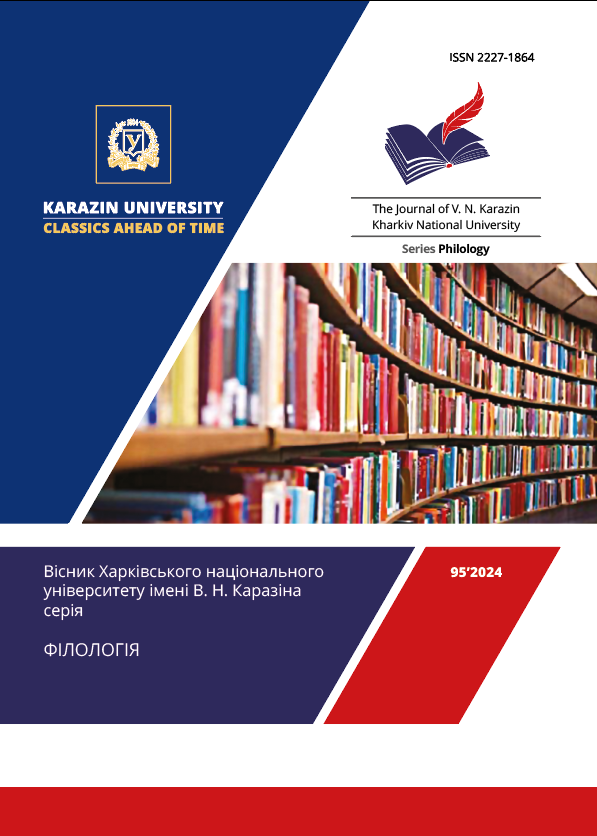The Military Vocabulary as a Component of Achilles Tatius’s Idiostyle
Abstract
The article attempts to characterize military vocabulary as an integral component of Achilles Tatius’s idiostyle, of an ancient Greek writer of the 2nd century AD, the author of one of the first love novels that have survived to our days in full – "Leucippe and Clitophon".
The purpose of the research was the classification, systematization and analysis of features of the vocabulary of the military sphere detected in the text of the novel, which required the use of analytical-descriptive, structural, quantitative methods. In the structure of the lexical idiosystem of Achilles Tatius’s novel the military vocabulary occupies a special place and includes 134 lexemes (706 word usages).
The scientific novelty of the obtained results lies in the fact that, for the first time, a systematic analysis of the vocabulary of military affairs in the work "Leucippe and Clitophon" was carried out in the article; military lexemes-terms were classified according to the lexical-semantic criterion into 10 thematic groups, among which the largest were "Military actions, maneuvering, tactics and strategy", "Military weapons and their use", and "Armed conflict"; the dominant ones among the military vocabulary (ὁ λῃστής, ἡ ναῦς, ὁ στρατηγός, τὸ ξίφος, ὁ πόλεμος, τὸ βέλος, ὁ σίδηρος, ὁ βουκόλος, ὁ στρατιώτης) are differentiated, which are considered as key words; the stylistic and functional role of individual lexical units belonging to the analyzed thematic groups is traced.
Among the lexemes of different thematic groups, non-equivalent vocabulary was found (τὸ ζῶμα, ὁ λοχαγός, ὁ λόχος, ὁ ὁπλίτης, ὁ παραστάτης, ὁ πελταστής, ὁ στρατηγός, ὁ βουκόλος, ἡ φάλαγξ), which serves to express military concepts absent in another culture or language, and a series of co-rooted words (the largest – 12 lexical units), which have different lexical meanings and belong to different parts of speech (ὁ στρατηγός, ὁ στρατιώτης, στρατικός, ὁ συστράτηγος, ἡ στρατεία, τό στράτευμα, ἡ στρατιά, τὸ στρατεπον, ὁ στρατος, συστρατεύομαι, στρατοπεδεύομαι, στρατεύομαι). The names of military concepts, objects, phenomena are included in the structure of many artistic figures (epithets, similes, oxymorons, hyperboles, metaphors, paraphrases).
Conclusions. Military terms and lexemes, skillfully used by Achilles Tatius, fully fulfill their definite-nominative function and influence the figurative system of the work, thus creating the unique writer’s idiostyle.
Downloads
References
Banzeruk, О.V., Shakura, Yu.О. Military vocabulary in P. Kulish's historical prose. Literature and Culture of Polissya. Vol. 59. Nizhyn: Mykola Gogol NSU, 2010. 15–20. [in Ukrainian].
Grytsenko, S. P. (2012). Trends in the development of the lexical-semantic group “Names of weapons and their parts” (based on the material of Ukrainian written monuments of the 16th-17th centuries)]. Collection of scientific works of Donetsk University. Studia Linguistica. Vol. 6. 345–367. [in Ukrainian].
Dubynets, Z.О. (2015). Military lexics in the novel „Malwy” by R. Ivanychuk. The Journal of V. N. Karazin Kharkiv National University. Series “Philology”. Vol. 73. 169–172. [in Ukrainian].
Colhan, О.V., Artemova H.О. (2017). Thematic organization of military terminology (the film “The tale of ardent years” by O. Dovzenko). Terminolohichnyi visnyk. Vol. 4. 253–259. [in Ukrainian].
Lysychenko, І. (2006). The lexical-semantic system of the Ukrainian language. Kharkiv: H.S. Skovoroda Kharkiv National Pedagogical University. 150 s. [in Ukrainian].
Lytovchenko, І. (2016). Dynamic processes in the military vocabulary of the Ukrainian language (names of weapons, ammunition, structures). Kryvyi Rih. 206 s. [in Ukrainian].
Nasminchuk, І. А. (2023). The military vocabulary as a component Maria Matios’s language creation. Scientific notes of V. I. Vernadsky Taurida National University", Series: “Philology. Journalism”. Tom 34 (73). № 5. 12–17. [in Ukrainian].
Panasiuk, K. (2018). Military terminology in the novel by Yurii Shcherbak “Weapons of doomsday”. Herald of L'viv Polynechnic National University. Series "Problems of Ukrainian Terminology". № 890. 66–69. [in Ukrainian].
Todorova, N.Yu., Lapina, M.O. (2022). Semantic characteristics of military vocabulary as part of English phraseological units. International Humanitarian University Herald. Series: “Philology”. № 54. 111–114. [in Ukrainian].
Yatsenko, N. О. (2000). Military vocabulary in Lina Kostenko's historical novels. Dyvoslovo. № 3. 30–32. [in Ukrainian].
Yatsenko, N. О. (2009). Formation of names of military clothing in the Ukrainian language. Kyiv: Dmytro Burago Publishing House. 180 s. [in Ukrainian].
Achilles Tatius / With an English translation by S. Gaselee, M. A. Fellow and Librarian of Magdalene College (1984). Cambridge, Massachusetts : Harvard University Press; London : William Heinemann LTD, 461 p. [in English].
Cioffi, R. (2024). Chapter 3. The Lives of Others: The Boukoloi, the Nile Delta, and the Frontiers of Knowledge in Achilles Tatius. Egypt, Ethiopia, and the Greek Novel: Between Representation and Resistance. Oxford University Press. 91–124. [in English]. https://doi.org/10.1093/oso/9780192870537.003.0004
Hilton, J. (2005). War and Peace in the Ancient Greek Novel. Acta Classica. XLVIII. 57–85. [in English].
Rutherford, I. (2000). The genealogy of the Boukoloi: how Greek literature appropriated an Egyptian narrative motif. The Journal of Hellenic Studies. Vol. 120. 106–121. [in English]. https://doi.org/10.1017/S0075426900019522




